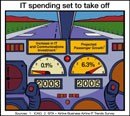Airlines Investments in IT will Boost Recovery - States SITA
 The results of the 2003 Airline IT Trends Survey - conducted annually by SITA and Airline Business magazine - show overall investment in IT and Communications (ITC) increased slightly this year to 2.4 per cent of revenue, despite the impact of the ‘perfect storm’ provoked by the combination of the SARS virus, war in Iraq, a prolonged economic downturn and the impact of September 11th 2001. In addition, as airlines look to the future, 75 per cent of airline chief information officers (CIO) said they expected to see ITC investment at the same level or higher in 2004.
The results of the 2003 Airline IT Trends Survey - conducted annually by SITA and Airline Business magazine - show overall investment in IT and Communications (ITC) increased slightly this year to 2.4 per cent of revenue, despite the impact of the ‘perfect storm’ provoked by the combination of the SARS virus, war in Iraq, a prolonged economic downturn and the impact of September 11th 2001. In addition, as airlines look to the future, 75 per cent of airline chief information officers (CIO) said they expected to see ITC investment at the same level or higher in 2004.
 Peter Buecking, SITA President comments: “Looking beyond the current structural and cyclical difficulties, cost advantage will still be a major determinant for competitive advantage, but so will service differentiation. Those airlines at the forefront of information technology are best positioned to win as we look forward to a sustained period of recovery.”
Peter Buecking, SITA President comments: “Looking beyond the current structural and cyclical difficulties, cost advantage will still be a major determinant for competitive advantage, but so will service differentiation. Those airlines at the forefront of information technology are best positioned to win as we look forward to a sustained period of recovery.”
Cost reductions and efficiency improvements were stated as the key driver of IT projects by two thirds of respondents, while 15 per cent (mainly low cost carriers) said improving revenue generation was the key driver and 15 per cent said it was improving customer service. In the last year half of respondents indicated that they had deferred projects due to cut backs in investment, and five per cent said that they had cancelled a project. The most important projects deferred or cancelled were financial systems, customer relationship management and sales applications.
“The speed of recovery and the success of airlines going forward will be determined by cost reductions and productivity improvements, and IT is key to achieving both. Not investing in IT is not an option - it’s about investing smartly”, Buecking continued. “IT is critical to the profitability of individual airlines and the overall success of the industry. Bold steps need to be taken by some airlines to outsource utility aspects, such as network, desktop, web hosting and datacentres and to move to flexible, usage-based charging of application service provision delivery. It is clear that IT must remain a strategic and vital part of their growth plans.”
However, for the third year running, a lack of investment and reduced budget was rated the top obstacle to achieving IT strategy goals by 64 per cent of respondents, followed by 38 per cent saying the challenges are caused by a lack of skilled IT people and 34 per cent by a lack of IT people with specific airline experience.
Given difficult times, the flexibility of the ASP model has become increasingly attractive, with over 80 per cent of airlines already using this mode, the most popular areas being reservations inventory/selling (50%), departure control/check-in (45%) and cargo reservation (21%). These areas plus frequent flyer applications and revenue accounting look likely to grow in the next few years as airlines look to take full advantage of the ‘pay as you use’ flexibility of ASP.
ADVERTISEMENT
Outsourcing of more aspects of IT looks set to continue, as in the next two years over half or airlines intend to have outsourced airline specific applications, web hosting, network management and desktop management. But a surprise was that 20 per cent stated that they do not plan to outsource any IT functions in the next couple of years.
The IT-enabled airline
To help airlines determine their IT priorities, the data from the survey reflects the current status and provides a set of benchmarks for comparison. For the five years that the study has been conducted, a model of the leading characteristics of an IT-enabled airline has emerged:
An IT enabled airline would:
? Have an IT strategy in place, looking 3 years ahead; lit would be led at Board level and have investment in IT at around 2.5% of revenue.
? Be already or rapidly moving to an IP infrastructure company-wide, for staff and partners.
? Be using the ASP model to deliver next generation open systems based applications.
? Outsource the non-competitive aspects of IT - network, desktop, etc
? Be sharing data, systems and integrating with alliance partners (or code-share partners).
? Distribute tickets over the web, giving priority to developing the airline web site, as well as expanding e-ticketing and corporate web sales.
? Be taking advantage of e-business systems to replace inefficient processes and reduce purchasing costs.
The Airline IT Trends Survey was conducted by NSM research in the first half of 2003 and 107 responses were received from the Top 200 carriers. Commissioned by SITA and Airline Business, the survey covers the essential strategic management issues of investment, drivers, obstacles, alliances and outsourcing, the adoption of open systems/IP technologies, and rise of business-to-consumer and e-business services. A detailed report and listing of the aggregate data is available to purchase on CD-Rom for US$245. For further information visit www.airlinebusiness.com
or www.sita.aero
.
——-

